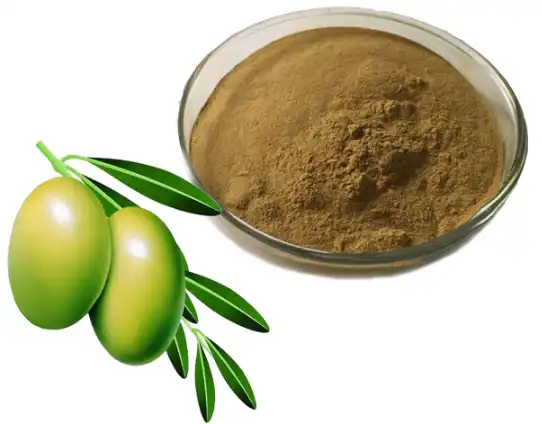Oleuropein powder and olive leaf extract are two popular natural compounds derived from olive trees, known for their potential health benefits. While they share a common source, there are significant differences between these two substances in terms of composition, concentration, and applications. This blog post will explore the key distinctions between it and olive leaf extract, helping you understand their unique properties and potential uses.
What are the main components of oleuropein powder?
Chemical structure of oleuropein
Oleuropein powder is a highly concentrated form of oleuropein, the primary phenolic compound found in olive leaves and unripe olives. The chemical structure of oleuropein is characterized by its secoiridoid nature, consisting of a glucose molecule linked to elenolic acid and hydroxytyrosol. This unique structure contributes to its potent antioxidant and anti-inflammatory properties. It typically contains a standardized concentration of this compound, often ranging from 20% to 40% or higher, depending on the extraction and purification methods used. The high concentration of oleuropein in this powder form allows for more precise dosing and potent effects when used in various applications.
Bioavailability of oleuropein powder
The bioavailability of oleuropein powder is an important factor to consider when comparing it to olive leaf extract. Due to its concentrated nature, oleuropein powder may offer enhanced absorption and utilization by the body. Studies have shown that oleuropein can be metabolized into various bioactive compounds, including hydroxytyrosol and elenolic acid, which contribute to its overall health benefits. The powder form of oleuropein may also allow for better dissolution and absorption in the gastrointestinal tract, potentially leading to improved bioavailability compared to less concentrated forms. However, it's important to note that individual factors, such as gut health and metabolism, can influence the bioavailability of oleuropein powder.
Applications of oleuropein powder in various industries
Oleuropein powder finds applications across various industries due to its potent antioxidant and antimicrobial properties. In the pharmaceutical industry, it is being investigated for its potential in treating cardiovascular diseases, diabetes, and neurodegenerative disorders. The cosmetic industry utilizes oleuropein powder in anti-aging formulations, leveraging its ability to protect skin cells from oxidative stress and promote collagen production. In the food and beverage sector, oleuropein powder serves as a natural preservative and flavor enhancer, extending the shelf life of products while imparting a mild, olive-like taste. Additionally, the nutraceutical industry incorporates oleuropein powder into dietary supplements, capitalizing on its potential health-promoting effects, including immune system support and blood pressure regulation.
How does olive leaf extract differ from oleuropein powder?
Composition of olive leaf extract
Olive leaf extract is a more complex mixture compared to oleuropein powder, containing a variety of bioactive compounds naturally present in olive leaves. While oleuropein is still a significant component of olive leaf extract, its concentration is typically lower than in oleuropein powder. The extract also contains other polyphenols such as hydroxytyrosol, tyrosol, and verbascoside, as well as flavonoids like luteolin and apigenin. This diverse array of compounds contributes to the broad spectrum of potential health benefits associated with olive leaf extract. The composition can vary depending on factors such as the olive tree variety, harvesting time, and extraction method used, resulting in a more complex and variable product compared to the standardized nature of oleuropein powder.
Synergistic effects of compounds in olive leaf extract
One of the key advantages of olive leaf extract over oleuropein powder is the potential for synergistic effects among its various components. The combination of different polyphenols, flavonoids, and other bioactive compounds may work together to enhance the overall health benefits. For example, while oleuropein is known for its antioxidant properties, the presence of other antioxidants like hydroxytyrosol in olive leaf extract may provide a more comprehensive protection against oxidative stress. Similarly, the anti-inflammatory effects of oleuropein may be complemented by other compounds in the extract, potentially leading to a more robust anti-inflammatory response. This synergistic action is not present in isolated oleuropein powder, which primarily relies on the effects of a single compound.
Comparing the health benefits of olive leaf extract and oleuropein powder
When comparing the health benefits of olive leaf extract and oleuropein powder, it's important to consider their different compositions and potential mechanisms of action. Oleuropein powder, being a concentrated form of a single compound, may offer more targeted and potent effects related to the specific properties of oleuropein. This can be advantageous in situations where a high dose of oleuropein is desired for particular health outcomes. On the other hand, olive leaf extract provides a broader range of potential benefits due to its diverse composition. It may be more suitable for general health support and prevention, as the various compounds work together to promote overall well-being. Both substances have shown promise in areas such as cardiovascular health, blood sugar regulation, and immune system support, but the specific outcomes and optimal applications may differ between the two.
What factors should be considered when choosing between oleuropein powder and olive leaf extract?
Desired health outcomes and specific applications
When deciding between oleuropein powder and olive leaf extract, it's crucial to consider the desired health outcomes and specific applications. Oleuropein powder may be more suitable for targeted interventions where a high concentration of oleuropein is required. For instance, if research indicates that oleuropein specifically benefits a particular health condition, using the powder form could provide a more precise and potent dose. On the other hand, olive leaf extract might be preferable for general health maintenance or situations where a broader spectrum of olive leaf compounds is desired. The choice between the two may also depend on the intended use, such as pharmaceutical formulations, dietary supplements, or food additives. Understanding the specific goals and requirements of the application will help guide the selection process between oleuropein powder and olive leaf extract.
Quality and standardization considerations
Quality and standardization are important factors to consider when choosing between oleuropein powder and olive leaf extract. Oleuropein powder typically offers a higher degree of standardization, with manufacturers often providing specific concentrations of the active compound. This standardization allows for more consistent dosing and more predictable effects, which can be advantageous in research settings or when developing pharmaceutical products. Olive leaf extract, while potentially offering a broader range of benefits, may have more variability in its composition due to factors such as the source of olive leaves and extraction methods used. When selecting either product, it's essential to choose reputable suppliers who can provide detailed information on the sourcing, extraction processes, and quality control measures employed. Additionally, third-party testing for purity and potency can provide further assurance of product quality for both oleuropein powder and olive leaf extract.
Cost-effectiveness and availability
Cost-effectiveness and availability are practical considerations when choosing between oleuropein powder and olive leaf extract. Oleuropein powder, being a more refined and concentrated product, may come at a higher cost per unit compared to olive leaf extract. However, its higher potency means that smaller amounts may be required to achieve desired effects, potentially balancing out the cost difference in some applications. Olive leaf extract, while generally less expensive, may require larger doses to achieve similar levels of oleuropein intake. The availability of these products can also vary, with olive leaf extract being more widely available in consumer markets due to its broader use in supplements and natural health products. Oleuropein powder may be more readily found in industrial or research settings. When making a decision, it's important to consider not only the upfront costs but also factors such as dosage requirements, intended use, and long-term supply reliability to determine the most cost-effective option for your specific needs.

Conclusion
In conclusion, while oleuropein powder and olive leaf extract share a common origin, they differ significantly in their composition, concentration, and potential applications. Oleuropein powder offers a highly concentrated, standardized form of the active compound, suitable for targeted interventions and precise dosing. Olive leaf extract, on the other hand, provides a broader spectrum of bioactive compounds that may work synergistically to offer diverse health benefits. The choice between the two depends on factors such as desired health outcomes, quality considerations, and cost-effectiveness. Both substances show promise in various health applications, and ongoing research continues to uncover their potential benefits. If you are also interested in this product and want to know more product details, or want to know about other related products, please feel free to contact lea_slsbio@163.com,WhatsApp+86 13193326505.
References
1. Barbaro, B., et al. (2014). Effects of the olive-derived polyphenol oleuropein on human health. International Journal of Molecular Sciences, 15(10), 18508-18524.
2. Omar, S. H. (2010). Oleuropein in olive and its pharmacological effects. Scientia Pharmaceutica, 78(2), 133-154.
3. Hashmi, M. A., et al. (2015). Phytochemical and pharmacological effects of olive leaf extract: A review. Trends in Food Science & Technology, 46(2), 132-143.
4. Vogel, P., et al. (2015). Polyphenols benefits of olive leaf (Olea europaea L) to human health. Nutrición Hospitalaria, 31(3), 1427-1433.
5. Lockyer, S., et al. (2017). Olive leaf phenolics and cardiovascular risk reduction: Physiological effects and mechanisms of action. Nutrition Reviews, 75(4), 299-315.
6. Şahin, S., & Bilgin, M. (2018). Olive tree (Olea europaea L.) leaf as a waste by-product of table olive and olive oil industry: A review. Journal of the Science of Food and Agriculture, 98(4), 1271-1279.


